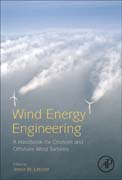
Wind Energy Engineering: A Handbook for Onshore and Offshore Wind Turbines
Letcher, Trevor M.
Wind energy is pivotal in global electricity generation and for contributing to achieving future essential energy demands and targets. In this fast moving field Wind Energy Engineering: an onshore guide is the most advanced, up to date and research focused text on all aspects of wind energy engineering. This must-have edition starts with an in-depth look at the present state of wind integration and distribution worldwide, and continues with a high-level assessment of the advances in turbine technology and how the investment, planning and economic infrastructure can support those innovations. Each chapter includes a research overview with a detailed analysis and new case studies looking at how recent research developments can be applied. Written by some of the most foreword thinking professionals in the field and giving a complete examination of one of the most promising and efficient sources of renewable energy this book is an invaluable reference into this cross-disciplinary field for engineers. Each chapter contains analysis of the latest high-level research and explores real world application potential in relation to the developmentsUses system international (SI) units and imperial units throughout to appeal to global engineersEach chapter offers measureable data written by a world expert in the field on the latest developments in this fast moving and vital subject INDICE: A. INTRODUCTION B. WIND RESOURCE How is wind generated? Wind speeds, wind force, wind power Theory of wind energy Wind power density Theoretical power captured by a wind turbine Wind distribution world-wide C. WIND TURBINE TECHNOLOGY History of harnessing wind power Design of horizontal axis wind turbines (power control, stall, generator torque, Yawing, electrical and mechanical braking, turbine size, generator type, blade design, material and count, tower height) Design of vertical axis wind turbines (, including Savonius type, designs, advantages) Aerodynamics (drag, lift, maximum power , axial momentum, angular momentum, wake rotation, blade element and momentum theory) Turbine blade size and maximum power output Wind Turbine components (blades, gearbox, rotor shaft, brake, magnets, etc) Variable speed drives Speed Power generation, synchronous and asynchronous generators Operation and Maintenance Wind energy measurements D. GENERATION OF ELECTRICITY Wind farms Integration into National Grids Small scale wind turbines Storing energy from wind turbines E. PLANNING and EXECUTION OF WIND PROJECTS Development Politics and public opinion Prospecting Financing Time frame Commissioning Installation F. WIND ENERGY WORLD WIDE Comparison of on-shore and off-shore Countries investing in on-shore wind power Countries developing and producing wind turbines G. ENVIRONMENTAL IMPACTS OF WIND ENERGY Life cycle of energy input and output Impact on wild life, impact on livestock Impact on humans, noise, landscape and aesthetics, community benefits and incentives, safety Land use Rare earth use (magnets) H. FINANCIAL MODELING/WIND ENERGY ECONOMICS Net energy gain, Energy return on investment (EROI) Incentives Revenue I. REGULATIONSJ. GROWTH TRENDS AND THE FUTURE OF WIND ENERGY
- ISBN: 978-0-12-809451-8
- Editorial: Academic Press
- Encuadernacion: Cartoné
- Páginas: 600
- Fecha Publicación: 01/05/2017
- Nº Volúmenes: 1
- Idioma: Inglés
